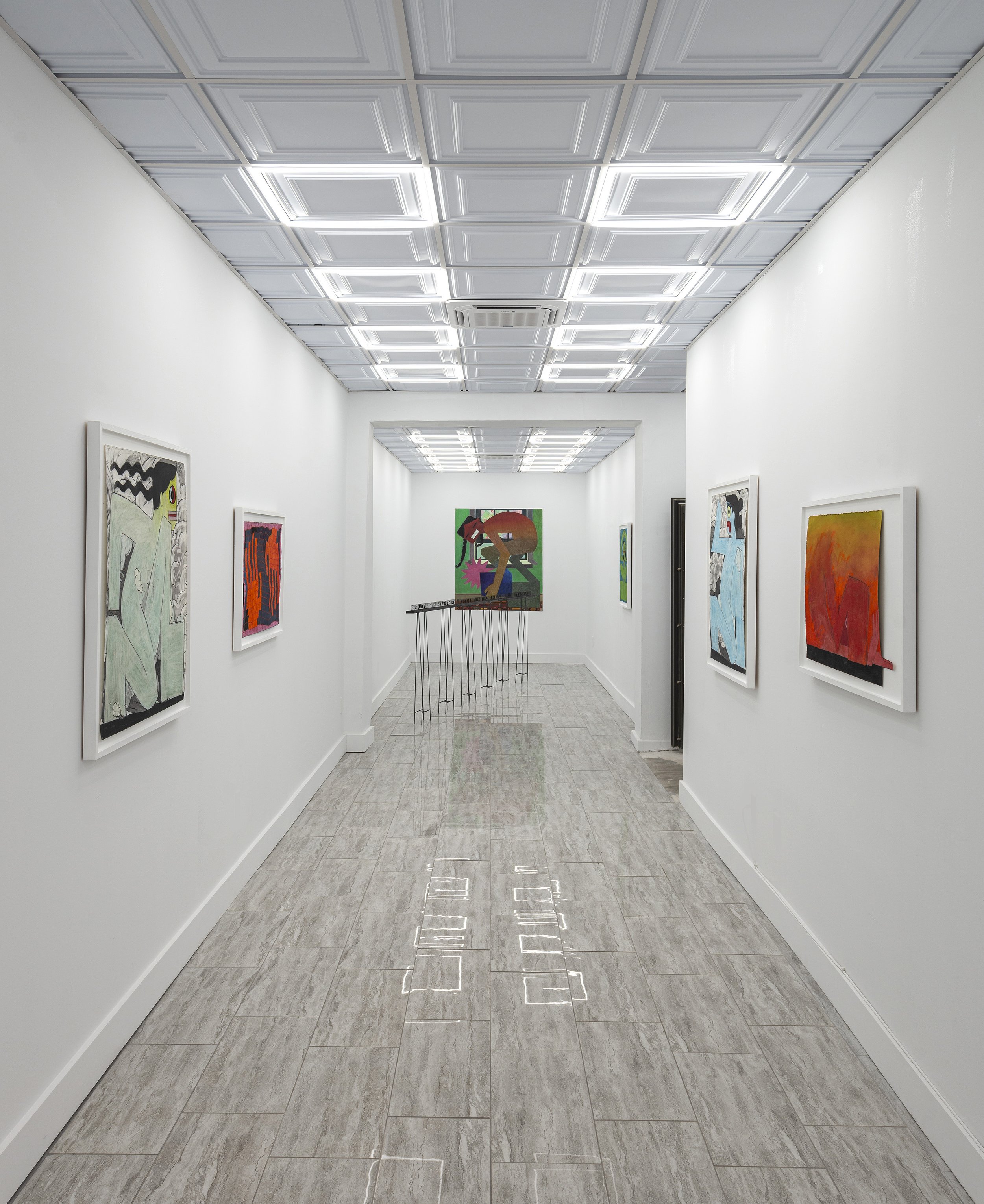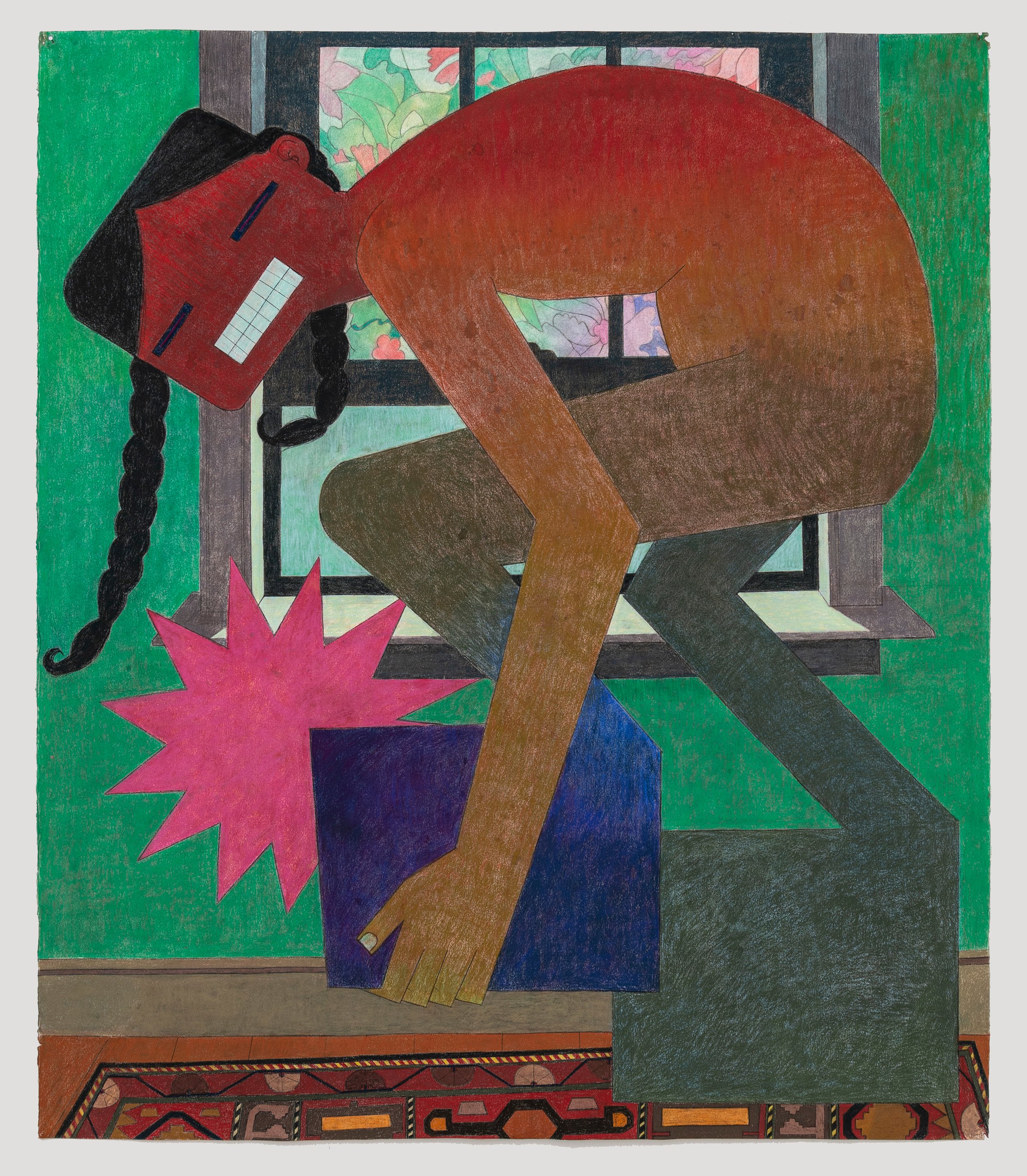CHRISTINA BARRERA
Between One Problem and Another
November 12th - December 11th 2022
Swivel Saugerties is pleased to present Between One Problem and Another, the first solo exhibition of Christina Barrera, featuring an array of new drawings and fiber works, as well as large-scale installation. As a first-generation Colombian-American artist, Barrera’s work often deals with questions of the body, identity, and colonialism, particularly in terms of how they relate to textiles and other forms of craft.
Her figurative drawings are at once ultra contemporary while concurrently paying homage to the glyphs and icons of Pre-Colonial South and Central America, a reclamation of what has been stolen and erased through colonization. I Can’t Afford To Keep On Standing, the towering centerpiece of the back gallery and her largest drawing on view, is especially exemplative of this. In this piece, an angular figure is hunched over, clutching at her own foot in pain; a starburst-like shape accompanies her blue foot, and makes the viewer utter “ouch.” Her body is a gradient wash of red, yellow, green and blue, conveying her anxiety and distress. Barrera’s use of color is often chosen with intention, with each pigment’s historical and cultural usage or connotations in mind. Even in works which don’t feature text, they relay it with immediacy. En la Calle II (On the Street II) operates in a similar manner, with simplified shapes and forms remitting complex emotions. However, the difference with this piece is that it was created on mended paper, with the act of mending historically representing invisible class and gender markers, as well as being a metaphor for the fallibility of political reform.
I Can’t Afford to Keep on Standing, 2022, Chalk Pastel and Charcoal on Paper, 60"H x 51"W
Her textiles are demonstrative of her effort to weave information into the very fabric of the work, down to the techniques she uses. The textile, sharing the same root as the word “text,” acts as a vessel for knowledge. Barrera integrates ideas from indigenous craftwork, such as the Andean quipu – a series of threads in which the varying knots represent different information and meanings – into her work. Like the quipu, she plays with layers of meaning and ambiguities in translation, such as in the piece A Parar Para Avanzar. In this work, a red, draping hammock (or chinchorro) is suspended from the ceiling, emblazoned with the words “A Parar Para Avanzar,” a phrase taken from the Colombian uprisings in 2019 and 2021. Parar means “to stop,” “to stand,” and in the context of labor, it means “to strike.” Her piece is a call to action, though which action is to be taken is up to the viewer .
A Parar Para Avanzar (To Stop to Advance or To Strike to Advance), 2022, Cotton-linen String, Hand-Dyed Cotton Mason Line, Wire, Wood, and Cobblestones from Tribeca, 228"H x 36"W x 168"W
Beyond the physical text, Barrera communicates through the different weaving techniques she uses. She merges ideas from indigenous crafts with European techniques, such as crocheting and smocking. This blending, perhaps even contradiction, of information represents a sort of dual identity. It acknowledges how indigenous craftwork still operates under imperialism, as well as her own identity as mestizo and the footprint of colonialism. This gesture drives home Barrera’s practice that is less interested in dogmatic results, but rather how it is made, and how that perception can differ through different lenses, as seen in the newest installation work I Hope The Fences We’ve Mended Fall Down Beneath Their Own Weight, a paper pulp and yarn technique entangled into steel mesh, which rests upon charred saw horses.
Her work is also highly tied to her own body, the labor of the body, and the information it holds. “I try as much as possible for my body to be my primary tool in my artwork,” says Barrera, “because it is a rare opportunity to be truly embodied in an experience of thinking.” The body is a container for knowledge, a tool for making, and a bridge that allows us to connect with others, but it is not without its limits. The weaving of textiles involves arduous, repetitive labor that takes a toll on the hands overtime. Part of Barrera’s practice includes resisting the back-breaking expectation of labor under capitalism, rather, letting her own body set the pace for her making.
To Push Across, 2019, Llama Yarn, Paper Pulp, Spray Paint, and Cochineal on Woven Cotton Net with Stretcher Bars, 8"H x 6"W
Barrera’s work truly embodies the famous adage “the personal is political.” The body is inextricably linked to questions of identity and labor, which in turn, is connected to colonialism. Her work is reminiscent of Chicana cultural theorist Gloria Anzaldúa’s idea of the “Borderlands,” and how our inner conflict over identity results in the external borders of our landscapes. “The struggle is inner: Chicano, indio, American Indian, mojado, mexicano, immigrant Latino, Anglo in power, working class Anglo, Black, Asian--our psyches resemble the bordertowns and are populated by the same people,” Anzaldúa says. “The struggle has always been inner, and is played out in outer terrains. Awareness of our situation must come before inner changes, which in turn come before changes in society. Nothing happens in the "real" world unless it first happens in the images in our heads.” Through her painstakingly wrought artworks, Barrera asks us to contemplate the borders within ourselves, our lands, and our universe.
Text by Brynn Knapik
En la Calle II (On the Street II), 2022, Chalk Pastel, Charcoal, and Ink on Mended Paper, 49"H x 38"W
The Net is For Holding, 2022, Chalk Pastel on Paper, 22"H x 33"W
En la Calle IV (On the Street IV), 2022, Chalk Pastel on Paper, 22"H x 36"W










